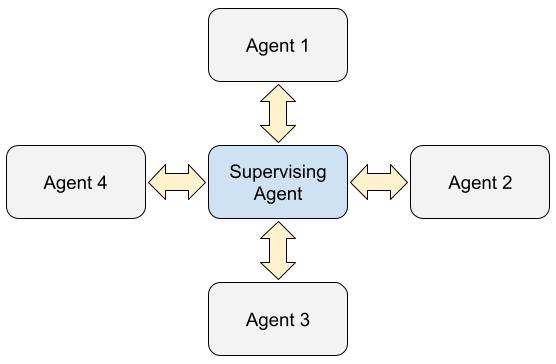Central
Centrally Controlled Systems
Centrally controlled systems are designed to manage and operate from a single point of control, typically through a central server or control unit.
This architecture streamlines decision-making and data processing, making it a common choice for various applications, particularly in environments where centralized management is essential.
Structure
- All decision-making, control, and processing happen at a central node or server.
- All other devices (clients) are dependent on this central hub for instructions and data processing.
Distributed
Distributed Systems

Distributed systems refer to a collection of independent computers or nodes that collaborate to achieve a common goal while appearing to users as a single coherent system.
These systems can operate over local area networks (LANs), wide area networks (WANs), or even the internet, allowing multiple devices to communicate and share resources seamlessly.
Structure
- Processing and decision-making are spread across multiple nodes.
- Each node operates semi-independently, collaborating with others to perform tasks.
Performance
Performance
Centrally Controlled Systems
- Performance can degrade if the central server becomes overloaded, leading to slower response times or system failures.
- Since there’s a single point of processing, the system can experience bottlenecks when handling large tasks or many users.
Distributed Systems
- Performance tends to scale better, as tasks are spread across multiple nodes.
- The system can handle more concurrent processes since work is distributed. Bottlenecks are less common.
Security
Security
Centrally Controlled Systems
- Security is concentrated at the central hub. If the central server is breached, the entire system can be compromised.
- Easier to manage security because all protective measures can be focused on a single point.
Distributed Systems
- Security can be more complex due to the multiple nodes, which increases the potential attack surfaces.
- However, the distributed nature means a compromise of one node doesn’t necessarily affect the entire system.
Scalability
Scalability
Centrally Controlled Systems
- Scalability is limited by the capacity of the central server.
- Expanding the system often requires significant upgrades to the central control point, which can be expensive and time-consuming.
Distributed Systems
- Distributed systems are highly scalable. New nodes can be added to the system to expand capacity with minimal disruption.
- Scaling is often smoother and more cost-efficient, particularly for cloud-based or peer-to-peer systems.
Fault Tolerance
Fault Tolerance
Centrally Controlled Systems
Highly vulnerable to failure at the central point. If the central node goes down, the entire system may fail.
Distributed Systems
More resilient to failure. If one node fails, others can continue to operate, providing redundancy and reducing downtime.
Use Cases
Examples and Use Cases
Centrally Controlled Systems
- Examples: Traditional banking systems, legacy enterprise systems, older networked databases.
- Use Cases: Smaller organizations, environments with less data traffic, applications that need a simple and highly controlled structure (e.g., point-of-sale systems).
Distributed Systems
- Examples: Cloud computing platforms (like AWS, Google Cloud), peer-to-peer networks, blockchain technology.
- Use Cases: Large organizations, high-availability environments, services needing fast and scalable solutions (e.g., global e-commerce, streaming services).
Management
Data Management
Centralized Controlled Systems
- Data Storage: Centralized in one repository
- Data Security: Concentrated security but a single point of vulnerability
- Data Backup and Recovery: Simplified backup and recovery
- Data Management: Easier updates and maintenanc
Distributed Systems
- Data Storage: Distributed across multiple nodes
- Data Security: More complex security, resilience against node failures
- Data Backup and Recovery: Redundant backups at each node, more complex recovery
- Data Management: Complex management and synchronization needs